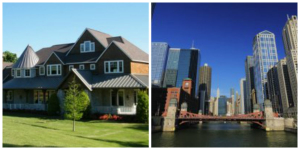
The story of the luxury real estate market in Chicagoland is really a tale of two markets. The city’s skyline is dotted with cranes as new buildings go up to accommodate more high-end apartments and condos. But in the suburbs, a dearth of new homes has led to strong demand among luxury buyers for existing homes and the few new developments that are under way.
There is plenty of good news for the overall housing market in Illinois at the close of 2017’s first quarter. Across the state, home sales increased 9.6 percent over the previous year and prices climbed 10.7 percent, according to Illinois Realtors. Statewide, 13,274 homes were sold for a median price of $189,900. Homes sold during March were on the market for an average of 67 days, down from 77 days in 2015.
On the whole, prices in the Chicago area are on the rise. According to the most recent Case Shiller Home Price Index for the Chicago Metro Area, single-family home prices in the city were up 0.2 percent over the previous month and increased about 5.8 percent year-over-year. Condo prices were down slightly month-over-month, dipping by 0.6 percent.
“There is a lot of pent-up demand for a generation that is aging and looking to downsize without sacrificing comfort,” says Tim Anderson, president of Northfield-based Focus Development. “Many of these downsizers end up moving to the city to find the high-quality home they are looking for, but for those who don’t want to move away from their friends and family, a luxury suburban option is in high demand.”
Lake Forest broker Andra O’Neill of @properties says the city is doing well, dealing with low inventory levels and high demand. “There are a number of younger families that enjoy the urban appeal and would like to stay here if they can afford it,” she says. “It is often about proximity to the city, to towns closer to the city seem to have more activity.”
But she also credits the expansion of companies in the north and northwest suburbs as draws for homebuyers to those areas.
“Caterpillar is a great example of this, as they just announced their move to Deerfield and will bring a number of buyers to Lake County.”
Luxury in the suburbs
While this is all certainly good news for Chicagoland housing markets, the luxury segment is another animal. In some Chicago suburbs, like Naperville and Burr Ridge, luxury home inventories became bloated in 2015 and into 2016, resulting in months’ supply of over six months. Indeed, the most recent RE/MAX Northern Illinois quarterly luxury market analysis shows that market times for homes $1 million and up had increased by the end of 2016, a 22 percent jump from 2015.
Christie Baines, an agent with Jameson Sotheby’s International Realty in Barrington, sees the mid-range and lower range of suburban luxury real estate as performing well, while acknowledging that sales are still slow for homes priced in the upper range above $1.5 million.
“We have a cross-section of listings running from mid-range all the way up to upper range,” Baines says. “The upper range is still a little sluggish. The mid-range at just under $1 million seems to have hit its stride. The homes that are priced over $1.5 million are still struggling through lack of showings and lack of buyers.”
Kipp Blackburn, an agent with CONLON/Christie’s International Real Estate, says that among suburban markets, there are a couple of areas showing substantial improvement, in particular Glenview, Glencoe and Winnetka. Blackburn references figures from his own year-over-year analysis of March 2017 MLS stats, using a marketing data tool called Infosparks that he accesses via the MLS platform connectMLS.
“In Glenview the median price is up 13 percent despite an increase in market time of 9 percent. Supply is up 32 percent, but contracts are up 56 percent year-over-year,” he says. “Glencoe closed sales are up 22 percent with an increase in median sales price of 12 percent, despite an increase in supply of homes. Sales activity is way up in Winnetka with 32 percent more sales and 25 percent more listings under contract. Supply is down 18 percent, but the median sales price is only up 1 percent year-over-year.”
O’Neill says there is a good amount of inventory and a range of options for buyers to choose from in the suburbs. “The best quality properties that are priced right are selling. Buyers prefer quality and homes that are ‘done’ versus bigger homes with more square footage and more land.”